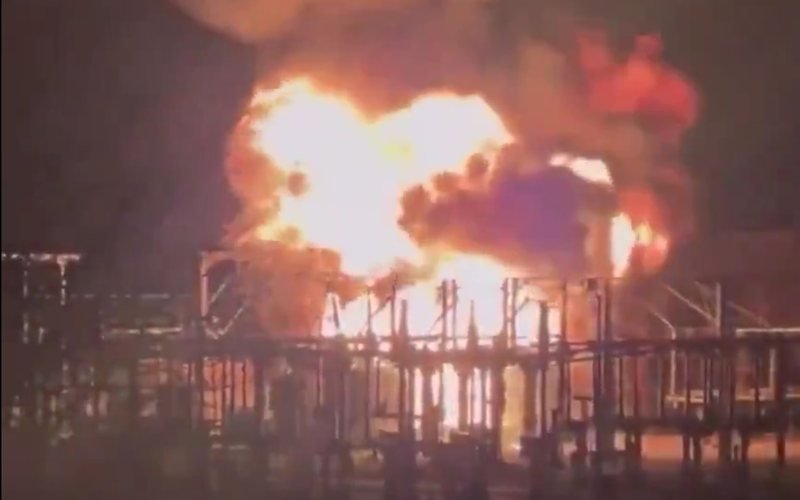[aviation news]
Official Report points out that technical failure ignored in 2018 caused the fire in a substation that paralyzed Heathrow airport
A final report released by the National Energy System Operator (Neso) pointed out that the catastrophic failure that caused the fire in an electrical substation near Heathrow airport in March since year, originated in a technical problem identified in 2018.
The incident left Heathrow airport, the busiest in Europe, virtually without energy, impacting more than 270,000 passengers and paralyzing its operations for almost 24 hours.
According to Neso, the fire was caused by an electrical failure in one of the high voltage bushings of a transformer located in the North Hyde substation, a structure that Heathrow depended mostly. The analysis indicates that the probable cause was the entry of moisture into the component, which had shown high moisture levels in oil samples collected in July 2018 – without, at the time, actions proportional to the gravity of the case were adopted.
@BBCLondonNews There’s a huge fire in Hayes – London, looks like North Hyde Electricity sub station pic.twitter.com/PJNpbHjZxu
– will (@fire_at_vill) March 20, 2025
The blecate occurred on the night of March 20 and demanded the performance of approximately seventy firefighters and ten vehicles. The airport remained closed for much of the next day, while teams worked in the reconfiguration of the internal network to redirect the energy from two other points of supply still operational. This process, according to Heathrow’s own administration, takes between ten and twelve hours.
In a statement, Fintan Slye, CEO of Neso, said that the objective of the report is to improve response and planning protocols in the face of great impact incidents as a way to strengthen the resilience of the energy system.
The report also points out that power operators are usually unaware of which customers are part of the critical national infrastructure – such as Heathrow – which can compromise the level of emergency readiness and prioritization.
Heathrow airport administrator said on Wednesday (2), who welcomed the report’s findings and blamed the lack of maintenance of electric infrastructure, regulatory obsolescence and the absence of effective security mechanisms as causes of failure.
According to the report, although the airport recognized that energy supply interruptions could significantly affect its operations, it evaluated the total loss of one of the three points of supply as a low -impact, low -impact event. Neso has therefore recommended that the airport diversifies its electric structure to prevent a single point failure from compromising the entire system.
Office of Gas and Electricity Markets, British regulator in the sector, announced the opening of a formal investigation against the National Grid Electricity Transmission (NGET). The investigation will seek to verify that the company has fulfilled legal and licensing obligations regarding the development and maintenance of the power grid in the North Hyde substation.
OFGEM also aims to discuss with the British Aviation Regulatory Agency (CAA) the lessons that the episode can offer to the broader resilience of the transport system.
In response to the report, National Grid said it had adopted additional measures from the fire, such as the full review of the oil analysis process, and declared support to the reports of the report and the investigation conducted by the ofge.
Heathrow also conducted an internal investigation, coordinated by former Minister Ruth Kelly, who pointed to 28 priority areas of improvement. The airport said it has already begun the implementation of all recommendations. One of the points highlighted by the review was the unavailability of Thomas Woldbye, CEO of the airport, at the initial moment of the incident, as his cell phone was in silent mode.
The North Hyde substation infrastructure, built before the implementation of current NGET fire control standards, also contributed to the severity of the case. In 2022, a review identified that fire suppression systems in two transformers were inoperative. A new report, held in July 2024, confirmed that the systems were still out of service – and that, in the event of a fire, there would be no proper restraint. A priority action was recorded to maintain the fog system of water, but it remained pending on the date of the incident seven months later.
The National Grid ready engineer arrived at the substation at 11:50 pm on the 20th. At 6 am on the 21st, London Firefighters were able to enter the scene after the issuance of electrical safety authorizations, according to the National Fire Department of Fire Department.
!function(f,b,e,v,n,t,s)
{if(f.fbq)return;n=f.fbq=function(){n.callMethod?
n.callMethod.apply(n,arguments):n.queue.push(arguments)};
if(!f._fbq)f._fbq=n;n.push=n;n.loaded=!0;n.version=’2.0′;
n.queue=[];t=b.createElement(e);t.async=!0;
t.src=v;s=b.getElementsByTagName(e)[0];
s.parentNode.insertBefore(t,s)}(window,document,’script’,
‘
fbq(‘init’, ‘1626712270970227’);
fbq(‘track’, ‘PageView’);
Share this content:

